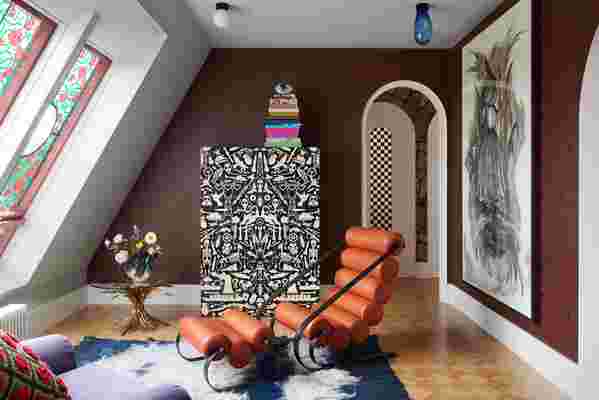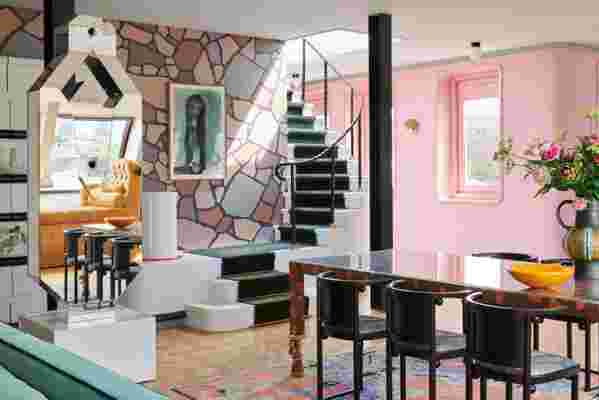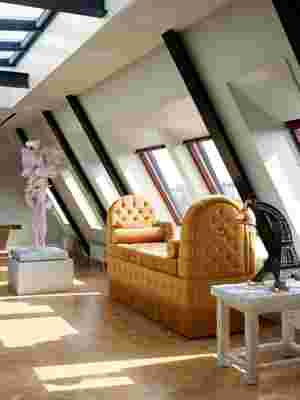Amusement parks are for the young. At least that’s the conventional wisdom. Job Smeets, however, has never put away childish things. For the founder of Studio Job, the provocative product-design firm, youthful recollections of Efteling—the largest theme park in the Netherlands—form the DNA of his defiantly kitsch creations. Imagine an armchair in the form of a ham-burger, a punching bag that appears to be made of red brick, and a table lamp that mimics a half-peeled banana. “If I can visualize those memories, I can explore new shapes and forms,” explains Smeets, who launched Studio Job, headquartered in the Dutch city of Tilburg, in 1998; it also has an outpost in Milan and is now represented by New York City gallery R & Company. “Not everybody needs to live in a modernist white box.”
That would include Rolf Snoeren, one half of Viktor & Rolf, the Amsterdam fashion house famed for surrealistic haute couture that would not look out of place in Efteling’s mock castle. “We try not to lose the inner child,” he explains of his and creative partner Viktor Horsting’s fantastical ensembles. “What they do in fashion,” Smeets responds, “I do in design.” The couturier’s American husband, Brandon O’Dell, the director of the Amsterdam Dinner Foundation, an NGO focused on the global fight against AIDS, calls the designers “cosmic brothers.” Born on the same day and in the same year, Snoeren and Smeets grew up only about 12 miles apart and likely crossed paths at Efteling, though they didn’t meet until they were in their 20s and working as interns at the same company in Paris. Snoeren also happens to be the godfather of Elvis, Smeets’s toddler son with art and design consultant Rebecca Sharkey. So when he and O’Dell purchased a penthouse in an 1890s former bank building on Keizersgracht, or Emperor’s Canal, Smeets was the only name on their short list, even though he’s conjured only a handful of interiors. “It’s not really something Job does,” Snoeren observes of the designer. “He makes things. But when we were talking about the apartment, he said, ‘I can do this.’ ”

a Kara Walker work surveys the bedroom lounge; Studio Job wall covering and cabinet, Marzio Cecchi lounge chair and ottoman, Claudy Jongstra carpet.
The results? Call it a temple to tomfoolery. After an 18-month renovation that was challenged by nightmarish permit mishaps and discussions largely conducted via WhatsApp, Snoeren and O’Dell settled into a gleeful Gesamtkunstwerk where nearly every element—from checkerboard--pattern glass panels to the button-tufted daybed where the couple like to gaze across rooftops in the company of their miniature dachshund, Little Rose—was conceived by Smeets. “It’s a celebration of our friendship,” Snoeren says, noting that the apartment was finished in March 2020, days before Amsterdam went into lockdown. “We moved in, and then we couldn’t leave.”
Given the wonderland that Smeets wrought, they were delighted to stay put. The front door is made of shiny brown resin textured with a hearty three-dimensional wood grain, as if taken off the hinges of a Playmobil fort. The living area’s gas fireplace is fronted by a gaping bronze mouth, flames flickering behind bared teeth. A built-in cabinet resembles a grinning robot face, and, à la Studio Job’s punching bag, the kitchen appears to be made of cartoon brick. Says Smeets: “It may not be the most functional kitchen, but for people who don’t cook, it’s a beautiful kitchen.” Walls are papered with a flagstone pattern that Wilma Flintstone would have adored, and a fabric bearing a Dutch artist’s scribbles of pneumatic nudes dresses Charlotte Perriand’s iconic chaise longue. The curved staircase adjacent to the dining area leads to a fire-engine-red roof terrace shaped like a heart. It’s invisible from the street, due to UNESCO restrictions for Amsterdam’s canal area; Snoeren wonders if it can be seen by planes passing overhead.

A David Altmejd mirror sculpture reflects the dining area. Josef Hoffmann chairs, Studio Job wallpaper, table, and carpet. The custom-made staircase accesses the roof terrace. Silk flowers by Jim Jon .
The wackiness is a purposeful rejection of the five-story canal house, just down the street, that Snoeren called home for a decade. “It felt like I was living in a status symbol,” the couturier recalls. The largely open-plan apartment, on the other hand, stretches across one floor (“I didn’t want any more stairs,” Snoeren says), is peppered with skylights, and offers city views that take in the late-19th-century church where the couple, who met at a yoga class, were married three years ago. Guests included human-rights crusader Princess Mabel of Orange-Nassau, who, at her own wedding to the Dutch king’s brother, wore a Viktor & Rolf dress bedecked with more than 200 crepe-georgette bows.

“I told Job we would give him carte blanche,” Snoeren continues, though he admits to having had second thoughts. The two designers can be equally stubborn, “so maybe it might not have been a good idea,” he gingerly allows. “Creating crazy and stunning is easy for him, but creating warmth, which Brandon wanted, is a bit more of a challenge.” The process went much more smoothly than he expected. O’Dell got the comfort and softness he desired—“The lines are graceful; the forms are rounded”—but he remembers that as the project progressed, “there were a few moments of ‘Oh, my,’ to be very honest.” One was Smeets’s suggestion, swiftly rejected, that he design penis-shaped light fixtures. Another surprise was a powder room tiled entirely in yellow—the color of urine, Smeets informed them. The primary bath, on the other hand, is a seemingly message-free shade of salmon.
Smeets’s cheeky inspiration for the powder room’s color scheme “never crossed my mind at all,” says Snoeren, still sounding a bit astonished. “All I could say is, ‘Oh, Job, thank you.’ It does make me laugh. I’m not the happiest person in the world, generally, so when a house can bring you happiness, that’s really something.”
